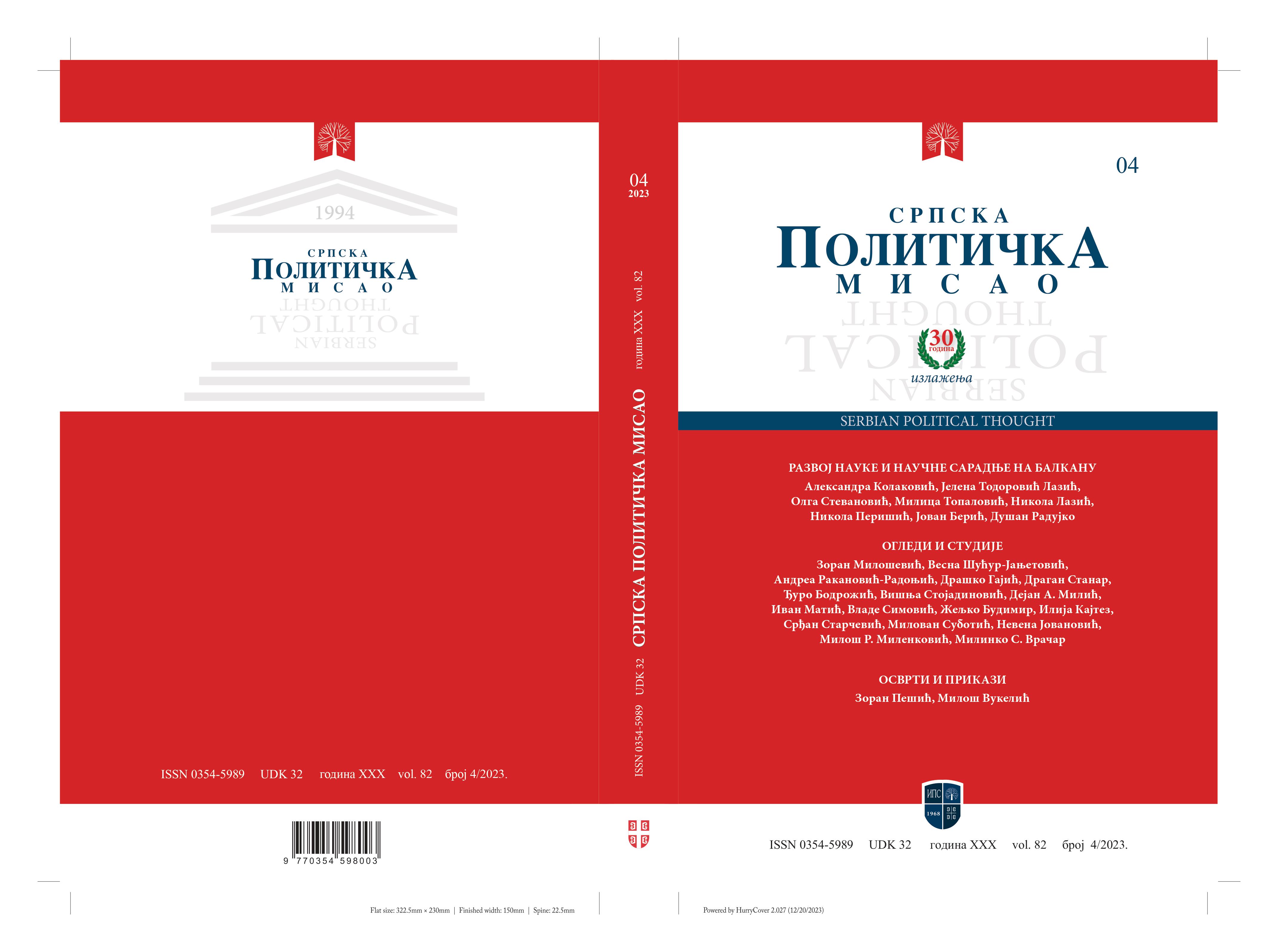GENDER EQUALITY IN THE FIELD OF RESEARCH AND INNOVATION - EU VERSUS SERBIA, NORTH MACEDONIA AND MONTENEGRO
Abstract
During the last decades, the EU has particularly focused on establishing equal opportunities and equal treatment of women and men in all spheres of life. Regulatory measures that the Union gradually introduced in the area of gender equality, such as: measures that ensure equal pay, maternity protection, regulations on parental leave, contributed to this. The She Figures publication, published by the European Commission every three years, uses the latest available statistics to monitor the state of gender equality in the field of research and innovation, thus providing us with the opportunity to parallelize data and analysis for 88 indicators across Europe. This is also the subject of this paper. One of the goals is to determine the extent to which the gender equality policy in the field of research and innovation is integrated in the associated countries: Serbia, North Macedonia and Montenegro, i.e., to what extent the data related to these three countries match or deviate from the average at the EU level based on the data provided by the aforementioned publication, 2021 edition. According to some indicators discussed in this Report, the situation is much better in these countries compared to the European average (number of women graduating from doctoral studies, total number of female researchers, number of female researchers employed in the main sectors of the economy). Also, for two important chapters we lack data for these three countries, so we cannot draw more comprehensive conclusions other than that these countries have largely included gender equality in their policies in the field of research and innovation and that in some categories they have even better results in favor of women than is the case in more developed countries of the European Union.
References
Arribas, Gracia Vara and Carrasco, Laura. 2003.”Gender equality and the EU – An assessment of the current issues.” Eipascope, 1: 1–9.
Avdeyeva, Olga. 2010. “State´s Compliance with International Requirements. Gender Equality in EU Enlargement Countries.” Political Research Quarterly, 62 (1): 203-217.
Costello, Cathryn. 2003. Gender equalities and the European Union Charter of Fundamental Rights, Economic and Social Rights under the Charter of Fundamental Rights of the European Union. Hart Publishing, pp. 111–138.
Consolidated version of the Treaty on European Union, https://eur-lex.europa.eu/resource.html?uri=cellar:2bf140bf-a3f8-4ab2-b506-fd71826e6da6.0023.02/DOC_1&format=PDF
Consolidated version of the Тreaty on the functioning of the Еuropean Union, https://eur-lex.europa.eu/LexUriServ/LexUriServ.do?uri=CELEX:12012E/TXT:en:PDF
https://www.consilium.europa.eu/en/press/press-releases/2023/04/24/gender-pay-gap-council-adopts-new-rules-on-pay-transparency/
Council conclusions. 2015. On advancing gender equality in the European Research Area, https://data.consilium.europa.eu/doc/document/ST-14846-2015-INIT/en/pdf
Council of Europe. 1998. Gender Mainstreaming – Conceptual framework, methodology and presentation of good practices – Final report of activities of the Group of Specialists on Mainstreaming, Strasbourg, https://www.unhcr.org/3c160b06a.pdf
Council of the European Union, Directive 75/117/EEC of 10 February 1975 on the approximation of the laws of the Member States relating to the application of the principle of equal pay for men and women, Official Journal of the European Union, L 45, Publications Office of the European Union, https://eur-lex.europa.eu/legal-content/ en/ALL/?uri=CELEX %3A31975L0117.
Defeis, Elizabeth. 1999. “The Treaty of Amsterdam: The next step towards gender equality?.” Boston College International and Comparative Law review, 23 (1): 1–33.
European Commission. 2010a. A strengthened commitment to equality between women and men: A women’s charter, COM(2010) 78
European Commission. 2010b. Strategy for equality between women and men 2010–2015, COM(2010) 491
European Comission, Directorate-General for Justice and Consumers. 2016. Strategic engagement for gender equality 2016-2019, European Commission, Publications Office, https://data.europa.eu/doi/10.2838/454429
European Commission. 2020a. A Union of equality: Gender equality strategy 2020–2025, COM(2020) 152 https://eurlex.europa.eu/legalcontent/EN/TXT/?uri=CELEX%3A52020DC0152&qid=1630498219130
European Commission. 2020b. A new ERA for Research and Innovation {SWD(2020) 214 final
European Commission. 2020c. Digital Education Action Plan 2021-2027. https://eur-lex.europa.eu/legal-content/EN/TXT/?uri=CELEX%3A52020DC0624
European Commission. 2020d. Women in Digital. https://digital-strategy.ec.europa.eu/en/library/women-digital
European Commission, Directorate-General for Research and Innovation. 2021. Horizon Europe, gender equality – A strengthened commitment in Horizon Europe, Publications Office, https://data.europa.eu/doi/10.2777/97891.
European Commission, Directorate-General for Justice and Consumers. 2022a. 2022 report on gender equality in the EU, Publications Office https://data.europa.eu/doi/10.2838/94579
European Commission. 2022b. Communication from the Commission to The European Parliament, The Council, The European Economic and Social Committee and the Committee of the Regions on achieving the European Education Area, COM(2022) 700 final
Hoskyns, Catherine. 1996. Integrating Gender – Women, law and politics in the European Union, London: Verso.
Jacquot, Sophie. 2014. L’égalité au nom du marché? Émergence et démantèlement de la politique européenne d’égalité entre les hommes et les femmes, Brussels: Peter Lang.
Joint communication to the European Parliament and the Council. 2020. EU gender action plan (gap) III – an ambitious agenda for gender equality and women’s empowerment in EU external action {SWD(2020) 284 final
Paraskevi Naskou-Perraki.2007. EU Gender Equality Law, Athens: Papazissis Publishers.
She Figures - Gender in Research and Innovation Statistics and Indicators, 2021.
Von der Leyen, Ursula. 2020. Political Guidelines for the Next European Commission 2019-2024 – Opening statement in the European Parliament plenary session 16 July 2019; Speech in the European Parliament plenary session 27 November 2019, Publications Office of the European Union, https://data.europa.eu/doi/10.2775/101756
Werner, Sandra. 2010. “EU Gender Equality Principles in EU Accession A case study of the current EU candidate countries Turkey and Croatia.“ http://essay.utwente.nl/60315/

